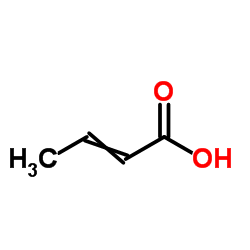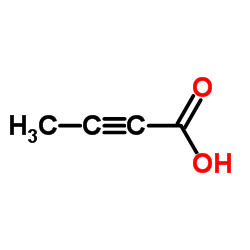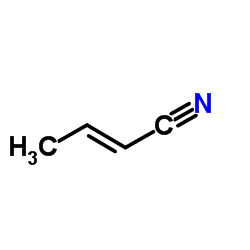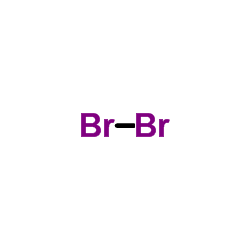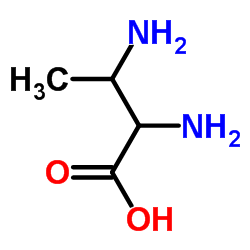600-30-6
| 中文名 | 2,3-二溴丁酸 |
|---|---|
| 英文名 | 2,3-dibromobutanoic acid |
| 英文别名 |
2,3-Dibrom-buttersaeure
EINECS 209-992-1 2,3-Dibromobutyric acid Butanoic acid,2,3-dibromo MFCD00014334 |
| 密度 | 2.114g/cm3 |
|---|---|
| 沸点 | 100-110°C 2mm |
| 熔点 | 86-90 °C |
| 分子式 | C4H6Br2O2 |
| 分子量 | 245.89700 |
| 闪点 | 100-110°C/2mm |
| 精确质量 | 243.87300 |
| PSA | 37.30000 |
| LogP | 1.61790 |
| 储存条件 | 贮存: 将密器密封,储存密封的主藏器内,并放在阴凉, 干爽的位置。 |
| 稳定性 | 性质与稳定性: 常温常压下,或不分解产物。 |
| 分子结构 | 五、分子性质数据: 1、 摩尔折射率:37.52 2、 摩尔体积(m3/mol):116.3 3、 等张比容(90.2K):312.1 4、 表面张力(dyne/cm):51.8 5、 极化率(10 -24cm 3):14.87 |
| 计算化学 | 1.疏水参数计算参考值(XlogP):1.8 2.氢键供体数量:1 3.氢键受体数量:2 4.可旋转化学键数量:2 5.互变异构体数量:无 6.拓扑分子极性表面积37.3 7.重原子数量:8 8.表面电荷:0 9.复杂度:94 10.同位素原子数量:0 11.确定原子立构中心数量:0 12.不确定原子立构中心数量:2 13.确定化学键立构中心数量:0 14.不确定化学键立构中心数量:0 15.共价键单元数量:1 |
| 更多 | 物性数据: 1. 熔点(℃):86-90
2. 沸点(ºC,2 mmHg): 100-110 3. 包装:5g |
Synonym:None known Section 2 - COMPOSITION, INFORMATION ON INGREDIENTS
Risk Phrases: 34 Section 3 - HAZARDS IDENTIFICATION EMERGENCY OVERVIEW
Causes burns.Corrosive.The toxicological properties of this material have not been fully investigated. Potential Health Effects Eye: Causes eye burns. May cause chemical conjunctivitis and corneal damage. Skin: Causes skin burns. May cause skin rash (in milder cases), and cold and clammy skin with cyanosis or pale color. Ingestion: May cause severe and permanent damage to the digestive tract. Causes gastrointestinal tract burns. May cause perforation of the digestive tract. The toxicological properties of this substance have not been fully investigated. May cause systemic effects. Inhalation: May cause severe irritation of the respiratory tract with sore throat, coughing, shortness of breath and delayed lung edema. Causes chemical burns to the respiratory tract. The toxicological properties of this substance have not been fully investigated. Aspiration may lead to pulmonary edema. May cause systemic effects. Chronic: Effects may be delayed. Section 4 - FIRST AID MEASURES Eyes: Get medical aid. Do NOT allow victim to rub eyes or keep eyes closed. Extensive irrigation with water is required (at least 30 minutes). Skin: Get medical aid immediately. Immediately flush skin with plenty of water for at least 15 minutes while removing contaminated clothing and shoes. Wash clothing before reuse. Destroy contaminated shoes. Ingestion: Never give anything by mouth to an unconscious person. Get medical aid. Do NOT induce vomiting. If conscious and alert, rinse mouth and drink 2-4 cupfuls of milk or water. Inhalation: Remove from exposure and move to fresh air immediately. If not breathing, give artificial respiration. If breathing is difficult, give oxygen. Get medical aid. Do NOT use mouth-to-mouth resuscitation. If breathing has ceased apply artificial respiration using oxygen and a suitable mechanical device such as a bag and a mask. Notes to Physician: Section 5 - FIRE FIGHTING MEASURES General Information: As in any fire, wear a self-contained breathing apparatus in pressure-demand, MSHA/NIOSH (approved or equivalent), and full protective gear. During a fire, irritating and highly toxic gases may be generated by thermal decomposition or combustion. Use water spray to keep fire-exposed containers cool. Contact with metals may evolve flammable hydrogen gas. Containers may explode when heated. Non-combustible, substance itself does not burn but may decompose upon heating to produce irritating, corrosive and/or toxic fumes. Extinguishing Media: Do NOT get water inside containers. For small fires, use dry chemical, carbon dioxide, or water spray. For large fires, use dry chemical, carbon dioxide, alcohol-resistant foam, or water spray. Cool containers with flooding quantities of water until well after fire is out. Section 6 - ACCIDENTAL RELEASE MEASURES General Information: Use proper personal protective equipment as indicated in Section 8. Spills/Leaks: Vacuum or sweep up material and place into a suitable disposal container. Clean up spills immediately, observing precautions in the Protective Equipment section. Avoid generating dusty conditions. Provide ventilation. Section 7 - HANDLING and STORAGE Handling: Wash thoroughly after handling. Use with adequate ventilation. Minimize dust generation and accumulation. Avoid contact with eyes, skin, and clothing. Do not breathe dust, vapor, mist, or gas. Keep container tightly closed. Avoid ingestion and inhalation. Discard contaminated shoes. Storage: Store in a tightly closed container. Store in a cool, dry, well-ventilated area away from incompatible substances. Corrosives area. Section 8 - EXPOSURE CONTROLS, PERSONAL PROTECTION Engineering Controls: Facilities storing or utilizing this material should be equipped with an eyewash facility and a safety shower. Use adequate ventilation to keep airborne concentrations low. Exposure Limits CAS# 600-30-6: Personal Protective Equipment Eyes: Wear appropriate protective eyeglasses or chemical safety goggles as described by OSHA's eye and face protection regulations in 29 CFR 1910.133 or European Standard EN166. Skin: Wear appropriate protective gloves to prevent skin exposure. Clothing: Wear appropriate protective clothing to prevent skin exposure. Respirators: A respiratory protection program that meets OSHA's 29 CFR 1910.134 and ANSI Z88.2 requirements or European Standard EN 149 must be followed whenever workplace conditions warrant respirator use. Section 9 - PHYSICAL AND CHEMICAL PROPERTIES Physical State: Solid Color: white Odor: none reported pH: Not available. Vapor Pressure: Not available. Viscosity: Not available. Boiling Point: Not available. Freezing/Melting Point: 86.00 - 88.00 deg C Autoignition Temperature: Not applicable. Flash Point: Not applicable. Explosion Limits, lower: Not available. Explosion Limits, upper: Not available. Decomposition Temperature: Solubility in water: Specific Gravity/Density: Molecular Formula: C4H6Br2O2 Molecular Weight: 245.90 Section 10 - STABILITY AND REACTIVITY Chemical Stability: Stable at room temperature in closed containers under normal storage and handling conditions. Conditions to Avoid: Incompatible materials, dust generation, excess heat. Incompatibilities with Other Materials: Oxidizing agents. Hazardous Decomposition Products: Carbon monoxide, irritating and toxic fumes and gases, carbon dioxide, hydrogen bromide. Hazardous Polymerization: Has not been reported Section 11 - TOXICOLOGICAL INFORMATION RTECS#: CAS# 600-30-6 unlisted. LD50/LC50: Not available. Carcinogenicity: 2,3-Dibromobutyric Acid - Not listed by ACGIH, IARC, or NTP. Section 12 - ECOLOGICAL INFORMATION Section 13 - DISPOSAL CONSIDERATIONS Dispose of in a manner consistent with federal, state, and local regulations. Section 14 - TRANSPORT INFORMATION IATA Shipping Name: CORROSIVE SOLID, ACIDIC, ORGANIC, N.O.S.* Hazard Class: 8 UN Number: 3261 Packing Group: III IMO Shipping Name: CORROSIVE SOLID, ACIDIC, ORGANIC, N.O.S. Hazard Class: 8 UN Number: 3261 Packing Group: III RID/ADR Shipping Name: CORROSIVE SOLID, ACIDIC, ORGANIC, N.O.S. Hazard Class: 8 UN Number: 3261 Packing group: III Section 15 - REGULATORY INFORMATION European/International Regulations European Labeling in Accordance with EC Directives Hazard Symbols: C Risk Phrases: R 34 Causes burns. Safety Phrases: S 26 In case of contact with eyes, rinse immediately with plenty of water and seek medical advice. S 28A After contact with skin, wash immediately with plenty of water. S 37 Wear suitable gloves. S 45 In case of accident or if you feel unwell, seek medical advice immediately (show the label where possible). WGK (Water Danger/Protection) CAS# 600-30-6: No information available. Canada None of the chemicals in this product are listed on the DSL/NDSL list. CAS# 600-30-6 is not listed on Canada's Ingredient Disclosure List. US FEDERAL TSCA CAS# 600-30-6 is not listed on the TSCA inventory. It is for research and development use only. SECTION 16 - ADDITIONAL INFORMATION N/A |
|
生态学数据: 三、生态学数据: 1、其它有害作用:该物质对环境可能有危害,对水体应给予特别注意。
|
| 危害码 (欧洲) | C: Corrosive; |
|---|---|
| 风险声明 (欧洲) | R34 |
| 安全声明 (欧洲) | S28A-S26 |
| 危险品运输编码 | 3261 |
| 包装等级 | II |
| 危险类别 | 8 |
| 海关编码 | 2915900090 |
|
~97% 
600-30-6 |
| 文献:Matveeva; Erin; Kurz Russian Journal of Organic Chemistry, 1997 , vol. 33, # 8 p. 1065 - 1067 |
|
~% 
600-30-6 |
| 文献:Synthesis, , p. 612 - 613 |
|
~% 
600-30-6 |
| 文献:Doklady Akademii Nauk SSSR, , vol. 14, p. 561 Chem. Zentralbl., , vol. 109, # I p. 1109 |
|
~% 
600-30-6 |
| 文献:Monatshefte fuer Chemie, , vol. 12, p. 416 |
| 上游产品 5 | |
|---|---|
| 下游产品 10 | |
| 海关编码 | 2915900090 |
|---|---|
| 中文概述 | 2915900090. 其他饱和无环一元羧酸及其酸酐(酰卤、过氧)化物、过氧酸及其卤化、硝化、磺化、亚硝化衍生物. 增值税率:17.0%. 退税率:9.0%. 监管条件:AB(入境货物通关单,出境货物通关单). 最惠国关税:5.5%. 普通关税:30.0% |
| 申报要素 | 品名, 成分含量, 用途 |
| 监管条件 | A.入境货物通关单 B.出境货物通关单 |
| 检验检疫 | R.进口食品卫生监督检验 S.出口食品卫生监督检验 M.进口商品检验 N.出口商品检验 |
| Summary | 2915900090 other saturated acyclic monocarboxylic acids and their anhydrides, halides, peroxides and peroxyacids; their halogenated, sulphonated, nitrated or nitrosated derivatives VAT:17.0% Tax rebate rate:9.0% Supervision conditions:AB(certificate of inspection for goods inward,certificate of inspection for goods outward) MFN tariff:5.5% General tariff:30.0% |



